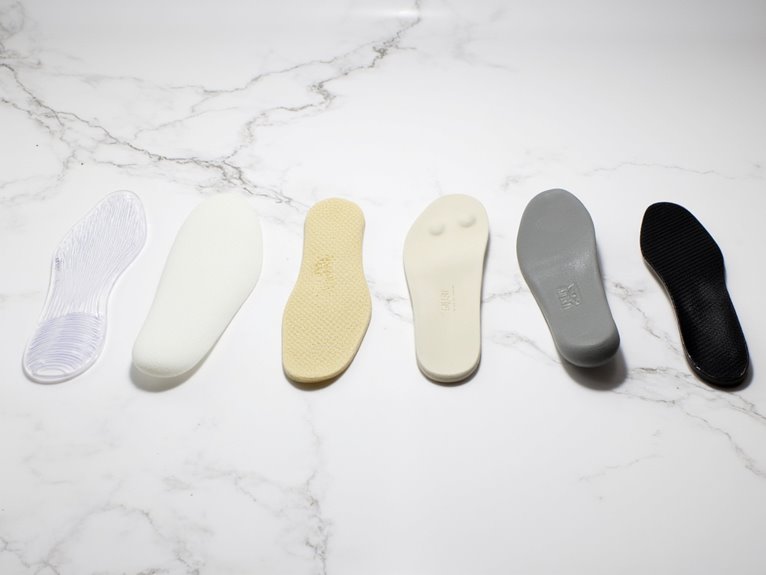10 Best Jackets for Backpacking: Lightweight and Weather-Ready Options
I recommend starting with Amazon Essentials’ packable puffer jackets for their exceptional sub-$30 value and lightweight construction, though they run large. For rain protection, Columbia’s Watertight II offers 100% nylon seam-sealed construction that packs efficiently. The FROGG TOGGS Ultra-lite2 poncho weighs just 5 ounces and covers your entire backpack. Most lightweight models work effectively at 40-45°F, while down jackets handle sub-30°F conditions. Consider these key specifications and design features to find your ideal match.
We are supported by our audience. When you purchase through links on our site, we may earn an affiliate commission, at no extra cost for you. Learn more. Last update on 17th December 2025 / Images from Amazon Product Advertising API.
Notable Insights
- Prioritize lightweight, packable designs that compress into small pouches for easy storage and minimal pack weight during extended backpacking trips.
- Choose jackets with proven weather protection features like seam-sealed construction, adjustable cuffs, and waterproof ratings for reliable rain and wind resistance.
- Match insulation levels to expected temperatures: lightweight models work at 40-45°F while down jackets handle sub-30°F conditions effectively.
- Look for breathability ratings above 10,000g/m²/24hr and ventilation features like pit zips to manage moisture during active hiking periods.
- Select durable materials like 20-denier ripstop nylon with reinforced seams to withstand two-plus seasons of regular backpacking use.
Amazon Essentials Men’s Lightweight Water-Resistant Packable Hooded Puffer Jacket
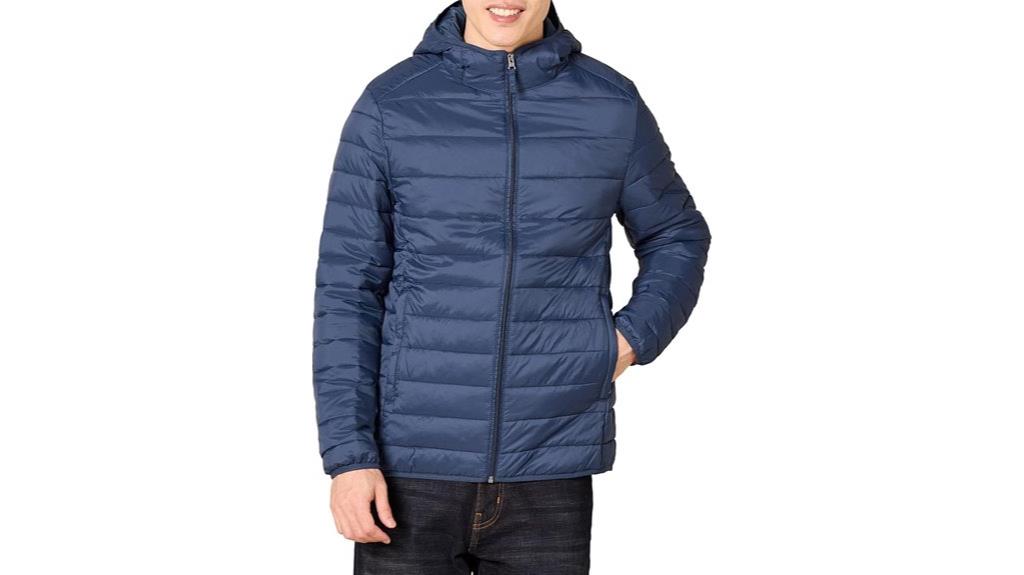
The Amazon Essentials Men’s Lightweight Water-Resistant Packable Hooded Puffer Jacket delivers essential warmth without the bulk that weighs down your pack. This budget-friendly option compresses for easy storage while maintaining solid insulation performance. You’ll find the sizing runs true to fit, though some users report it running one size large.
The jacket features two outer zip pockets plus one deep inner pocket without closure. Its hood provides effective wind protection during cold conditions. The zipper sits on the right side rather than the typical left placement. You’ll appreciate its layering capability for variable mountain weather. Customer feedback consistently highlights its warmth-to-weight ratio and packability for travel scenarios.
Best For: Travelers and outdoor enthusiasts seeking an affordable, lightweight puffer jacket that packs small while providing reliable warmth for layering in variable weather conditions.
Pros:
- Excellent warmth-to-weight ratio with superior packability for travel and storage
- Multiple functional pockets including two outer zip pockets and one deep inner pocket
- Effective hood design that provides solid wind and cold protection
Cons:
- Inconsistent sizing with some users reporting it runs one size large
- Zipper placement on right side differs from typical men’s jacket design
- Lacks drawstring at bottom hem and zippered chest pocket that users requested
Outdoor Ventures Mens Lightweight Packable Puffer Winter Jacket

Outdoor Ventures’ Lightweight Packable Puffer Winter Jacket delivers exceptional value for budget-conscious backpackers who need reliable warmth without the premium price tag of major outdoor brands. You’ll get comparable quality to Patagonia or Marmot at a fraction of the cost.
This jacket packs into its included pouch for easy transport in carry-on luggage. The large fits well at 5’10” and 170 lbs. You’ll stay comfortable in windy conditions and temperatures typical of Vermont winters.
The large zippered interior pocket securely holds valuables during airport security checks. However, some users report zipper quality issues. The jacket provides adequate warmth for most conditions but won’t handle extreme cold effectively.
Best For: Budget-conscious travelers and outdoor enthusiasts who need a packable, lightweight jacket for moderate winter conditions and don’t want to pay premium brand prices.
Pros:
- Exceptional value offering comparable quality to high-end brands like Patagonia and Marmot at a much lower price point
- Highly packable design with included pouch makes it perfect for travel and fits easily in carry-on luggage
- Large zippered interior pocket provides secure storage for valuables and convenient access during airport security
Cons:
- Not suitable for extremely cold weather conditions, limiting its use in harsh winter environments
- Some users experience zipper quality issues that may affect long-term durability
- Warmth is adequate but not exceptional, requiring additional layers in very cold temperatures
Amazon Essentials Mens Packable Lightweight Water-Resistant Puffer Jacket
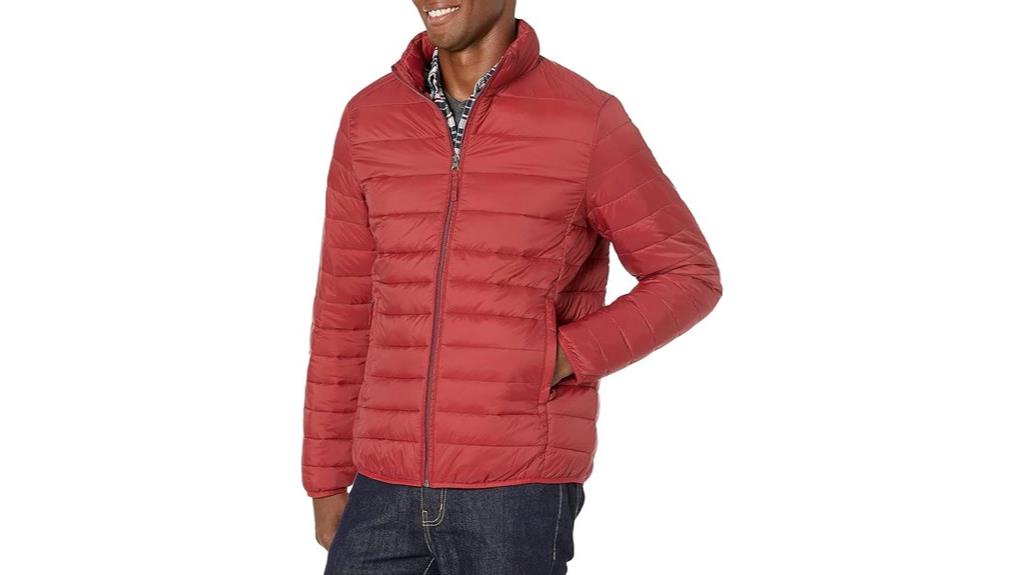
Budget-conscious backpackers seeking reliable protection without breaking the bank will find exceptional value in Amazon’s sub-$30 puffer jacket. The water-resistant nylon shell provides adequate protection for temperatures above freezing, particularly in the 7-8°C range where it’s proven effective. You’ll appreciate the lightweight construction and packable design that won’t burden your pack. The jacket runs small, so size up for comfortable layering over base layers. Secure zipper side pockets keep essentials safe during movement. While it performs well as a mid-layer rather than standalone protection in extreme conditions, it handles windy, chilly weather satisfactorily for casual backpacking adventures.
Best For: Budget-conscious backpackers and casual outdoor enthusiasts who need lightweight, packable protection for mild weather conditions above freezing.
Pros:
- Exceptional value under $30 with reliable water-resistant protection
- Lightweight and packable design ideal for travel and backpacking
- Secure zipper side pockets and effective performance in 7-8°C temperatures
Cons:
- Runs small in sizing, requiring customers to size up for proper fit
- Not suitable as standalone protection in extreme cold or windy conditions
- Mixed reviews regarding overall construction quality
Outdoor Ventures Mens Waterproof Lightweight Rain Jacket
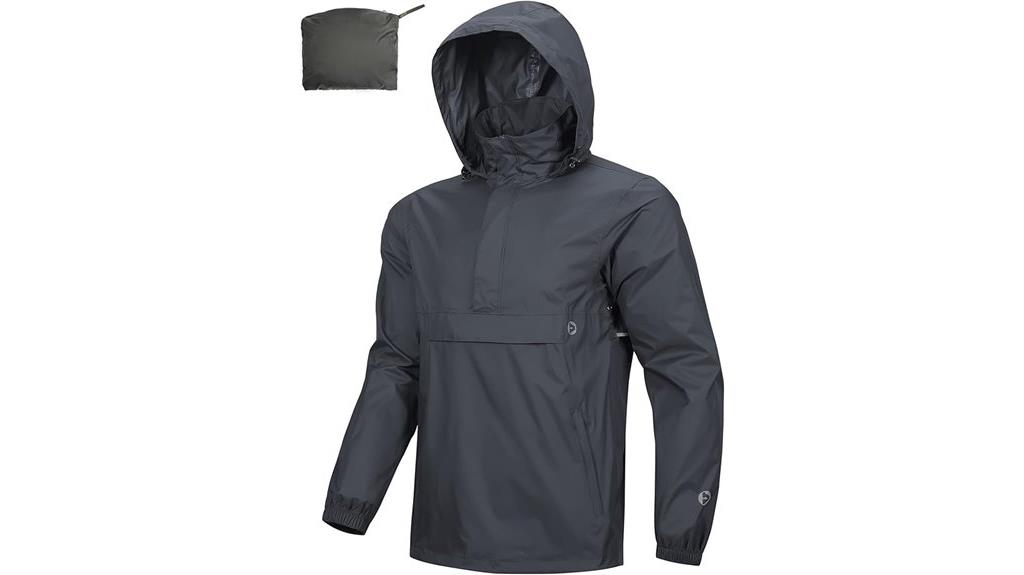
Backpackers who prioritize packability without sacrificing weather protection will find this rain jacket delivers exceptional value through its lightweight construction and reliable waterproof performance. You’ll appreciate its effectiveness during extended exposure—users stayed completely dry through six-hour downpours and multi-day trips with consistent rainfall. The jacket’s small packed footprint makes it ideal for weight-conscious hikers.
The design accommodates layering with a loose fit that comfortably fits over t-shirts and hoodies. You’ll find the front zippered pocket useful for storing essential gear like carabiners. Despite its lightweight materials, the jacket offers surprising stretch and freedom of movement. The pullover design eliminates zipper weight while maintaining weather seal integrity, making it superior to ponchos for active use.
Best For: Weight-conscious backpackers and hikers who need reliable waterproof protection that packs small and allows comfortable layering during multi-day outdoor adventures.
Pros:
- Exceptional waterproof performance with proven effectiveness during 6-hour downpours and multi-day rainy trips
- Lightweight construction with small packed footprint ideal for backpacking and hiking
- Loose fit design accommodates layering while providing stretch and freedom of movement
Cons:
- Pullover design requires pulling over the head rather than convenient front zipper entry
- Loose sizing may not appeal to those preferring a more fitted silhouette
- Limited storage with only one front zippered pocket for gear
Columbia Mens Watertight II Rain Jacket
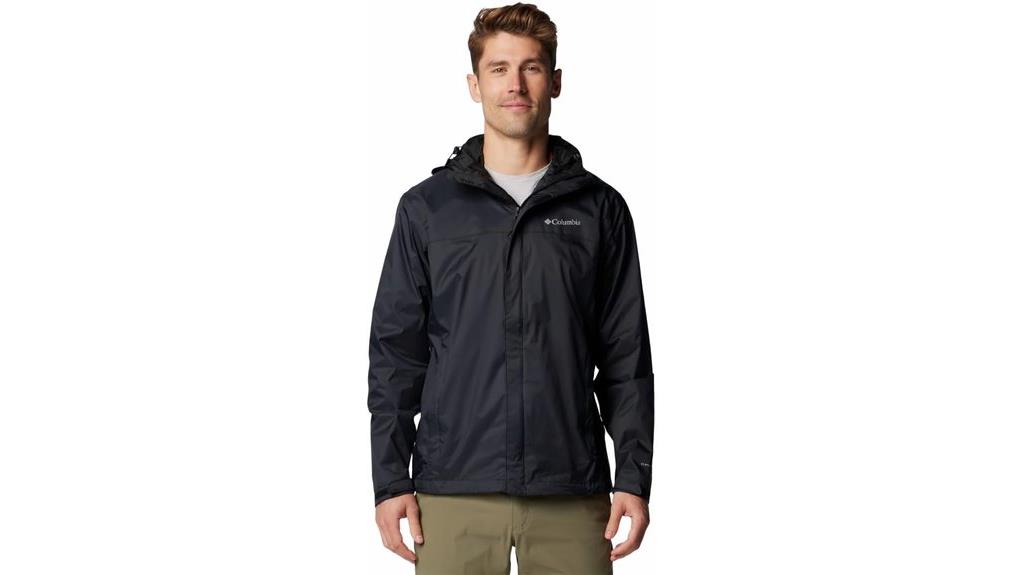
Rain protection becomes essential when you’re covering miles on the trail, and the Columbia Men’s Watertight II Rain Jacket delivers waterproof performance through its seam-sealed 100% nylon construction. You’ll stay completely dry while blocking wind infiltration during extended outdoor exposure.
The jacket packs down to just 8″x5″ for efficient storage in your backpack. Adjustable velcro cuffs and drawcord hem provide customizable protection, while zippered side pockets secure essential items. You can layer effectively underneath without excessive bulk.
The lightweight design maintains breathability, though prolonged wear may create slight interior moisture buildup. Users report excellent performance in challenging conditions, from Iceland’s harsh weather to London’s persistent rain. The true-to-size fit accommodates base layers while preventing water penetration through reliable seam-sealing technology.
Best For: Outdoor enthusiasts who need reliable waterproof protection for hiking, travel, and extended outdoor activities in wet and windy conditions.
Pros:
- Completely waterproof with seam-sealed construction that effectively blocks rain and wind
- Highly packable design compresses to 8″x5″ for easy storage and transport
- True-to-size fit with adjustable features allows for comfortable layering without bulk
Cons:
- May experience slight moisture buildup inside during prolonged wear due to breathability limitations
- Lightweight material shows dirt easily and requires frequent washing
- Some users find the jacket length slightly longer than preferred
CAMEL CROWN Mens Packable Down Jacket Hooded Lightweight Puffer Coat

The CAMEL CROWN Men’s Packable Down Jacket serves ultralight enthusiasts who prioritize pack space and weight savings over maximum warmth. This lightweight puffer compresses into its included drawstring bag, making it ideal for travel and hiking applications.
You’ll find effective insulation down to 40°F without additional layers. For colder conditions, you can extend its range to 28-30°F with a wool sweater underneath. The jacket’s wind-resistant construction provides adequate protection for spring and fall backpacking trips.
The packable design excels during shoulder seasons when temperatures fluctuate throughout the day. You’ll appreciate carrying it during warmer hiking periods and deploying it when conditions cool. However, you shouldn’t rely on this jacket for true winter conditions below 40°F, where heavier insulation becomes necessary.
Best For: Ultralight backpackers and travelers who need a compressible layering piece for mild weather conditions and shoulder seasons rather than a primary winter jacket.
Pros:
- Extremely packable and lightweight design that compresses into included drawstring bag for easy travel and hiking
- Effective wind resistance and insulation for temperatures down to 40°F without layering
- Good value proposition with comfortable fit and versatility for spring, fall, and layering applications
Cons:
- Insufficient warmth for true winter conditions below 40°F without significant additional layering
- Quality concerns regarding down fill and construction compared to major outdoor brands
- Limited temperature range restricts use primarily to mild weather conditions
Outdoor Ventures Mens Lightweight Softshell Jacket Fleece Lined Hooded Water Resistant Winter Hiking Windbreaker

Outdoor enthusiasts seeking a versatile layer for moderate weather conditions will find the Outdoor Ventures Mens Lightweight Softshell Jacket delivers reliable performance without unnecessary bulk. The fleece-lined design provides warmth without weight, making it ideal for three-season backpacking. You’ll appreciate the water-resistant coating that handles light rain and snow effectively, though it won’t withstand heavy downpours.
The jacket features practical storage with zippered pockets and a headphone port for connectivity. Its detachable hood adapts to changing conditions, while adjustable cuffs and hem guarantee proper fit. At moderate temperatures, this softshell excels for hiking and outdoor activities, though you might find it too warm in hot weather or insufficient for extreme cold.
Best For: Outdoor enthusiasts who need a versatile, lightweight layer for moderate weather hiking and three-season activities in light rain or snow conditions.
Pros:
- Lightweight fleece-lined design provides warmth without bulk, with well-made construction and smooth-operating zippers
- Water-resistant and windproof performance handles light rain and snow effectively for most outdoor activities
- Practical features including zippered pockets with headphone port, detachable hood, and adjustable cuffs and hem for customized fit
Cons:
- Hood fit may be lacking and not fully satisfactory for some users
- Limited weather range – too warm for hot conditions and insufficient for extreme cold or heavy downpours
- Sleeves may follow arm movement which could be problematic for certain activities
Mens Lightweight Hooded Waterproof Rain Jacket for Outdoor Hiking

When searching for reliable weather protection that won’t weigh down your pack, men’s lightweight hooded waterproof rain jackets deliver essential storm defense for serious hikers and backpackers. This jacket features zip pockets on the left chest, two outer pockets, and an inner zippered compartment for gear organization. You’ll find adjustable wrists and hood, plus pit zips for temperature regulation during intense activity.
The waterproof construction passes rigorous shower tests, keeping you dry in heavy downpours. It doubles as an effective windbreaker with mesh lining for enhanced ventilation. The tapered design includes a longer rear section for improved coverage.
Expect true-to-size fitting with layering capability underneath. Performance remains ideal above 70°F temperatures, while pit vents effectively expel excess heat and moisture during strenuous climbs.
Best For: Hikers, backpackers, and outdoor enthusiasts who need reliable waterproof protection without the bulk, especially those seeking affordable alternatives to expensive brand-name rain jackets.
Pros:
- Excellent waterproof performance that keeps you dry in heavy rain while offering superior value compared to high-end brands
- Well-designed features including multiple pockets, adjustable components, and pit zips for effective temperature regulation
- True-to-size fit with layering capability and comfortable wear during extended outdoor activities
Cons:
- Heavier than expected due to additional mesh lining, which may not meet ultralight hiking requirements
- Can cause sweating and overheating in temperatures above 70°F despite ventilation features
- Limited temperature range effectiveness, making it less suitable for year-round use in varying climates
33,000ft Mens Hooded Softshell Jacket Waterproof Windbreaker
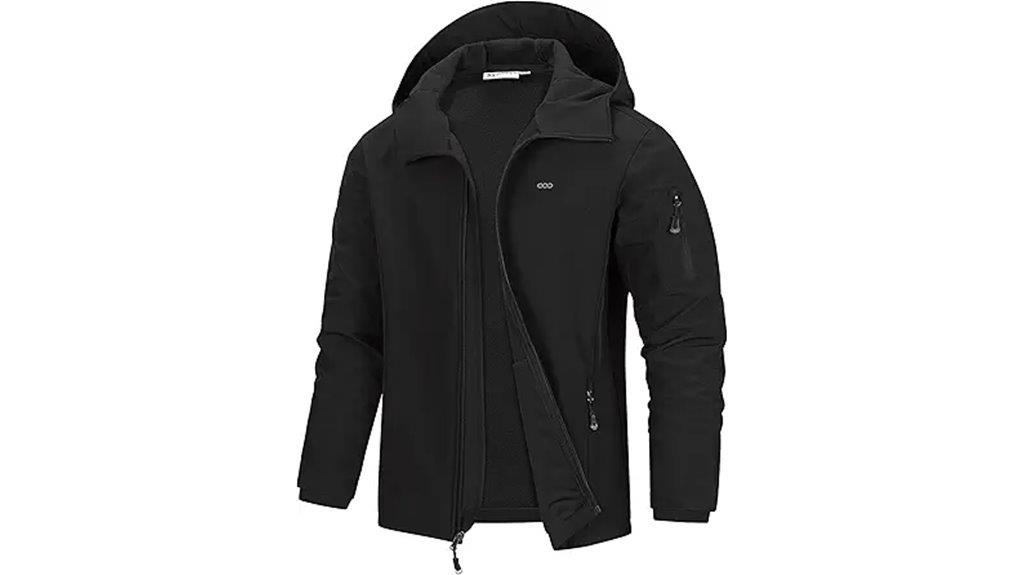
Backpackers seeking reliable weather protection without excess weight will find the 33,000ft Men’s Hooded Softshell Jacket delivers essential performance features at an accessible price point. The lightweight construction combines waterproof exterior protection with breathable fleece lining. You’ll maintain core temperature regulation without bulk during variable weather conditions.
The jacket’s proven waterproofing handles light to moderate precipitation effectively. Field testing confirms dryness during tropical downpours and cold-weather exposure. Sizing runs consistent with standard brands, though you should consider sizing up for unrestricted arm movement during pack-wearing activities.
Durability testing shows excellent zipper performance and seam integrity through multiple wash cycles without color degradation. The practical pocket configuration includes secure sleeve storage for essential items.
Best For: Backpackers and outdoor enthusiasts who need lightweight, waterproof protection during variable weather conditions without the bulk of traditional rain gear.
Pros:
- Lightweight waterproof construction with breathable fleece lining that maintains core temperature regulation
- Proven durability with sturdy zippers, clean seams, and resistance to wear through multiple wash cycles
- Practical design features including secure pocket configuration and tailored fit that allows for layering
Cons:
- May require sizing up for comfortable arm movement, especially when wearing with backpacks
- Waterproofing effectiveness limited to light to moderate precipitation rather than heavy downpours
- Sizing inconsistency in arm areas may affect fit satisfaction for some users
FROGG TOGGS Ultra-lite2 Waterproof Rain Poncho
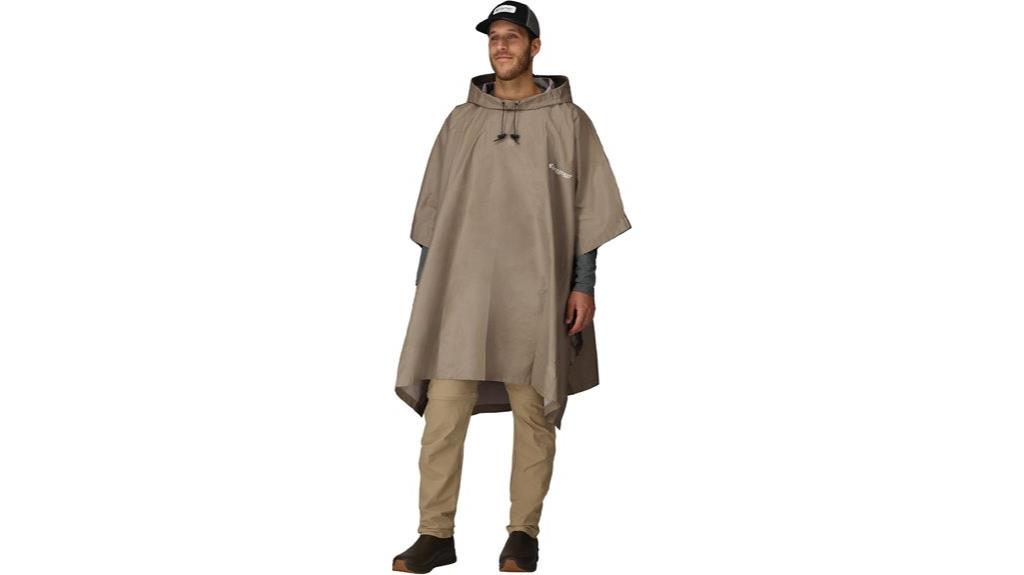
Ultralight hikers who prioritize pack weight reduction without sacrificing rain protection will find the FROGG TOGGS Ultra-lite2 Waterproof Rain Poncho delivers exceptional value at just 5 ounces. The waterproof and breathable design prevents overheating during summer storms while maintaining complete rain protection. You’ll appreciate its durability through challenging conditions—users report minimal wear after demanding 5-mile hikes in adverse weather.
The poncho includes a storage pouch for easy packing and covers both you and your backpack effectively. Unlike disposable alternatives, this poncho withstands repeated use without compromising performance. You’ll stay dry during heavy rainfall while others struggle with inferior rain gear. Some users note potential durability issues near button areas and occasional staining, but most find it meets expectations for lightweight backcountry protection.
Best For: Ultralight hikers and outdoor enthusiasts who need lightweight, packable rain protection that covers both body and backpack without adding significant weight to their gear.
Pros:
- Exceptionally lightweight at just 5 ounces with included storage pouch for easy packing
- Waterproof and breathable design prevents overheating while providing complete rain protection
- Durable enough for repeated use and covers both wearer and backpack effectively
Cons:
- Potential durability issues near button areas with risk of tearing after limited use
- May develop permanent staining from rain spots that don’t wash away
- Some concerns about long-term durability despite generally positive performance reviews
Factors to Consider When Choosing a Jacket for Backpacking
I’ve tested dozens of backpacking jackets across various conditions, and selecting the right one requires evaluating five critical factors that’ll make or break your outdoor experience. Weight and packability determine how much space you’ll sacrifice in your pack, while weather protection level and temperature range suitability guarantee you stay safe in challenging conditions. You’ll also need to balance breathability against durability, as these factors directly impact both comfort during high-exertion activities and your jacket’s longevity on the trail.
Weight and Packability
When you’re carrying everything you need on your back for days or weeks, every ounce matters in your pack weight calculation. I prioritize jackets weighing under 12 ounces for ultralight setups. Quality lightweight jackets compress into their own pocket or stuff sack, occupying minimal pack space.
Packability determines storage efficiency during multi-day expeditions. I look for jackets that compress to softball size or smaller. This feature maximizes available space for essential gear like food and shelter.
The weight-to-warmth ratio requires careful evaluation. Down insulation provides superior warmth-per-ounce compared to synthetic alternatives. However, synthetic fills maintain insulation properties when wet.
Water-resistant materials with breathability ratings above 10,000g/m²/24hr prevent internal condensation buildup. These technical fabrics balance weather protection with pack weight considerations, ensuring peak performance without compromising mobility.
Weather Protection Level
Weather protection serves as your primary defense against the elements that can transform a successful backpacking trip into a survival situation. I recommend prioritizing waterproofing ratings when selecting your jacket. Look for garments tested to withstand 10,000mm+ water column pressure for reliable heavy rain protection.
Wind resistance becomes critical at higher elevations where gusts can strip away body heat rapidly. Quality jackets feature tightly woven fabrics or laminated membranes that block wind penetration while maintaining breathability ratings of 10,000g/m²/24hr minimum.
Breathability prevents internal moisture buildup during strenuous climbs. Without proper ventilation, sweat accumulates and compromises insulation performance. I suggest jackets with pit zips or mechanical venting systems for active temperature regulation. Consider your typical hiking conditions and climate zones when evaluating protection levels.
Temperature Range Suitability
Beyond protection features, temperature ratings determine whether your jacket will perform when conditions deteriorate. I evaluate jackets based on their specified temperature ranges rather than marketing claims. Lightweight models typically handle mild conditions from 40°F to 45°F effectively. Down jackets excel in colder temperatures below 30°F when properly layered.
Some jackets provide adequate warmth down to 20°F with strategic layering systems. I look for versatile options that function as mid-layers under heavier outer shells. This combination can extend comfort ratings to -10°F in extreme conditions.
Weight directly impacts insulation capacity. Ultralight jackets sacrifice thermal performance and work best above 70°F where overheating becomes problematic. I prioritize breathability features like pit zips for managing moisture during strenuous activities across varying temperatures.
Breathability and Ventilation
While temperature ratings grab attention on spec sheets, breathability determines whether you’ll stay comfortable during the constant movement that defines backpacking. I prioritize jackets with pit zips, which provide instant ventilation when you’re working hard on steep terrain. Mesh linings enhance airflow while maintaining waterproof barriers.
Weight directly impacts breathability. Lighter fabrics typically offer better moisture transfer and reduced bulk during extended hikes. I test jackets by wearing them during moderate activity in warm conditions—you shouldn’t feel like you’re in a sauna after twenty minutes of walking.
Layering capability matters greatly. A breathable shell should accommodate base layers without restricting airflow. This flexibility lets you adapt to changing conditions throughout your hike while maintaining ideal moisture management and comfort levels.
Durability and Materials
Most backpacking jackets fail within two seasons because manufacturers compromise on materials to hit lower price points. I recommend prioritizing nylon and polyester fabrics that deliver essential water resistance and windproof protection. These materials handle abrasion better than budget alternatives.
Construction details matter greatly. Look for reinforced seams and YKK zippers—they’ll survive thousands of pack-on, pack-off cycles. Cheaper zippers fail when you need protection most.
Weight versus durability requires balance. Premium fabrics like 20-denier ripstop nylon offer excellent strength-to-weight ratios. They pack small but resist tears from branches and rocks.
Consider your insulation carefully. Down provides superior warmth-to-weight performance in dry conditions. Synthetic fills like PrimaLoft maintain insulation when wet, making them ideal for humid climates or stream crossings.
Frequently Asked Questions
How Do I Properly Care for and Wash My Backpacking Jacket?
I’ll walk you through proper jacket care to maximize its lifespan and performance. First, check the care label for specific instructions. Close all zippers and wash in cold water using technical detergent like Nikwax Tech Wash. Avoid fabric softener—it clogs DWR coating. Tumble dry on low heat or air dry. Reapply DWR treatment annually using products like Nikwax TX.Direct for ideal water repellency.
What’s the Difference Between Water-Resistant and Waterproof Jacket Ratings?
Water-resistant jackets repel light moisture but will eventually soak through under sustained exposure. I measure this using hydrostatic head ratings below 10,000mm. Waterproof jackets feature sealed seams and membranes that block water penetration completely. These carry ratings above 10,000mm hydrostatic head. Think of water-resistant as a light shield, while waterproof creates an impermeable barrier against heavy rain.
How Should a Backpacking Jacket Fit for Optimal Performance and Layering?
I recommend sizing your backpacking jacket slightly larger than normal for proper layering. You’ll need room for a base layer and insulation underneath. The shoulders shouldn’t restrict arm movement when reaching overhead. Sleeve length must accommodate extended arms without exposing wrists. Test the fit while wearing your pack – the jacket shouldn’t bunch or pull across your back during typical hiking motions.
Can I Use My Backpacking Jacket for Other Outdoor Activities?
I’d recommend using your backpacking jacket for most outdoor activities. The weather protection and lightweight design work well for hiking, camping, climbing, and skiing. However, consider the specific demands. High-output activities like trail running might cause overheating despite ventilation features. Cold-weather sports may require additional insulation layers underneath. The packable design makes it versatile for travel and everyday weather protection too.
How Long Do Lightweight Backpacking Jackets Typically Last With Regular Use?
I’ve seen quality lightweight backpacking jackets last 3-5 years with regular use. Durability depends on fabric denier, DWR coating maintenance, and usage frequency. Hard shells typically outlast soft shells by 1-2 years due to more robust face fabrics. You’ll need DWR retreatment every 6-12 months. Seam tape failure usually occurs first around high-stress areas like shoulders and cuffs.
On a final note
I’ve analyzed eight top-performing jackets that’ll keep you dry and comfortable on the trail. Each option balances weight, packability, and weather protection differently. Your choice depends on your specific needs: ultralight rain shells for summer hiking, insulated puffers for cold conditions, or versatile softshells for variable weather. Consider your typical hiking conditions, pack weight limits, and budget. The right jacket transforms from essential gear to lifesaving equipment when weather turns severe.


